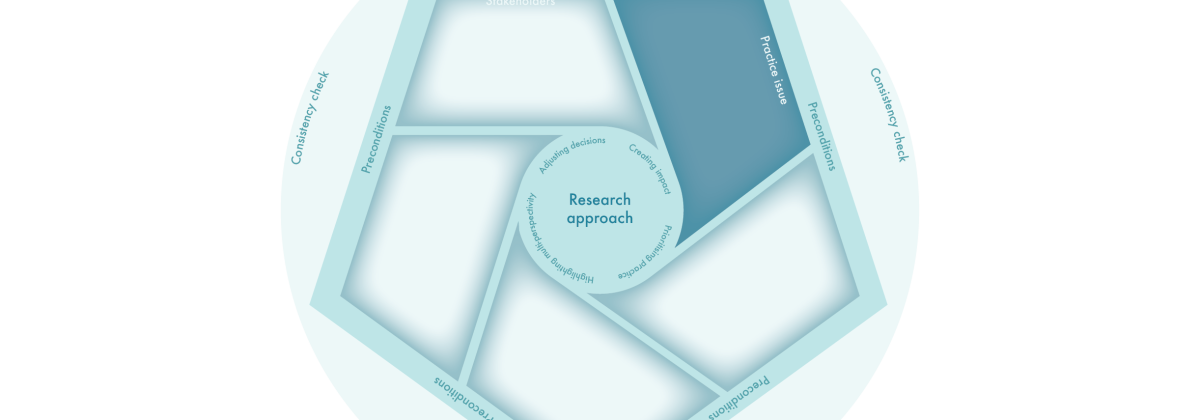The knowledge, working methods and tools offered in this element can be used by researchers at their own discretion for one or more of the objectives below:
- collectively gaining a better understanding of the ways in which different members of the partnership look at the practice issue from their own perspective
- collectively gaining further insight into factors involved in the practice issue
- collectively making a choice for issue delineation
What is a practice issue?
The term ‘practice issue’ is used within the CAYR methodology to denote the problem or opportunity in practice that the research project will focus on. This means that a practice issue can be a description of a problem or an opportunity. A problem is a situation that is perceived as undesirable by stakeholders. An opportunity is a possibility seen to improve practice. When we focus on a practice problem, it is important to also formulate it as a problem, i.e. an undesirable situation. For example: ‘The diagnostics of …. do not provide sufficient guidance for … to arrive at appropriate treatment.’ The formulation names a concrete situation for a specified target group and indicates what is lacking. A practice issue is not: a desired outcome or aim, an objective, a solution, or a question.
Required preliminary work by project leader and process manager
It is important for project leaders to have sufficient knowledge of the issue and the practice in which it arises. This means knowledge of causes and consequences and knowledge of the different actors involved in the issue as well as their interests and positions. For process managers, it is important to have some information in advance on the participants and the issues they consider important (also refer to the ‘Getting all stakeholders in position’ element on this website).
Tips for project leaders and process managers
Researchers have a lot of knowledge of the object of their study. Consequently, they often already have strong ideas about what the practice issue is and what is needed to address it. In practice-based research, it is important to leave these ideas be for a while and to be open to the perspectives of practitioners themselves. Experts, professionals, companies, managers and other stakeholders can suggest unexpected aspects that can provide depth and are important for the impact of the research project in practice.
At the same time, the analytical skills of the researcher and process manager are needed to structure the conversation. Don’t be afraid to take the lead in classifying causes and effects, but always check your ideas with stakeholders in practice. Also aim for delineation of the issue. What will we include and exclude in the study, given the conditions for the project? Make a summary of the results and test them next time in the project group.
It is good to realise that research is not the right answer to every single practice issue. If, looking back, a practice issue turns out not to be problematic, then research is unnecessary. The same applies if the knowledge needed to tackle the problem is already available. Alternatively, a study may be desired but not feasible or realistic, or the question may be so complex that it cannot be answered. And it also happens that a particular design may be desired (such as a randomised experiment), which then turns out not to be feasible in the situation at hand. So, while talking or thinking about each component of the Circling Model, reasons may arise to decide not to do research but to do something else (for example, embarking on a change process or adapting policy in the practice context).
Helpful working methods
Card methodology
The card methodology can be used to collectively gain a better understanding of the ways in which different members of the partnership look at the practice issue from their own perspective. In this method, participants devise as many solutions to the practical issue as possible as a first step. Then the group collectively tries to deduce what causes the problem, based on the solutions given.
Supporting questions: Practice issue
Project leaders and process managers can use these supporting questions for themselves to get an overview of all facets of a practice issue. This set of questions can serve as a checklist.
Contemplative dialogue
This working method can help in making collective choices in the delineation of the practice issue. Contemplative dialogue is a form of conversation that alternates writing, reading aloud, listening and quoting each other. In doing so, the aim is to seek common ground together. The final step is a conversation in which participants look for common themes in their contributions. This can help achieve
More information and tools for describing the practice issue
The ‘CAYR as a complete 10-step process’ manual includes a complete workshop described on page 24 called ‘practice issue exploration’. In this workshop, different working methods are combined to jointly achieve depth and focus within the practice issue with a project group. The workshop is a half-day session and can be organised either online or on-site. The description of this workshop can give project leaders and process managers more insight into how the above-mentioned working methods and tools can be used (whether combined or not) and can serve as inspiration for how meetings can be organised from the basic principles of CAYR.
Additional helpful resources
- Duiveman, R. (2018). Making research relevant to policymaking : from brokering boundaries to drawing on practices. Policy Studies, 0(0), 1–19. https://doi.org/10.1080/01442872.2018.1539226
- Van den Berg, N., & Teurlings, C. (2019). Van probleem naar onderzoeksvraag. Den Haag: Kennisrotonde.
- Van der Velde, M., Munneke, L., Jansen, P., & Dikkers, J. (2020). Onderzoekend vermogen in de praktijk. Hilversum: Concept Uitgeefgroep.
- Vermaak, H. (2009). Plezier beleven aan taaie vraagstukken. Deventer: Kluwer.
- Zegel, J. D. (2016). Van probleem naar prestatie; in 6 stappen naar een praktijkopdracht (2e druk). Hilversum: Op de i.
Website: www.musework.nl
